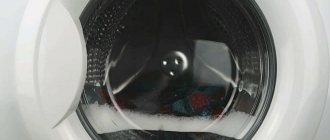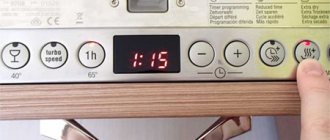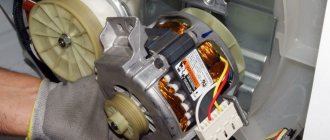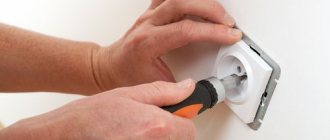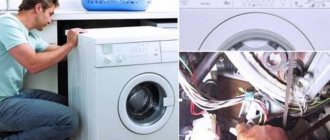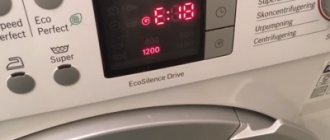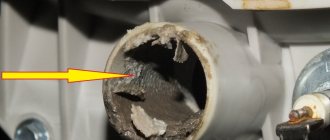The impeller of the SMA drain pump often fails. In such a situation, experts recommend completely replacing the pump. But a real Russian person, undoubtedly, would be sorry to throw away a functioning pump because of a faulty plastic part. You can try to replace the impeller, and if the process goes smoothly, the pump will return to normal operation and continue to pump out water without any problems. Let's figure out how to remove the impeller from the washing machine pump and how to restore the functionality of the drain element.
Impeller dismantling process
If you decide to remove the impeller from the pump with your own hands, we will help you with this. Let us present a detailed algorithm for dismantling a plastic part. So, after the drain pump is removed from the washer body, perform the following manipulations:
- cut off the plastic part located at the end of the impeller with a hacksaw;
- forcefully pull out the prefabricated base together with the impeller from the water pump;
- insert the removed structure into a vice and securely fix it in it;
- Take 2 flathead screwdrivers and, placing them on the bottom of the plastic screw, gently press upward on the impeller with upward movements.
At this stage, the main thing is not to overdo it and not to break the fastening of the drain pump impeller.
After lifting and pulling the impeller up, it should fly off the mount. When the plastic impeller is removed, you will see the shaft that powers it.
Now you need to remove the metal shaft from the overall structure. To do this, unscrew the vice from the tabletop, turn it over and reinstall it so that the compression bars are on the bottom. After this, the element to be disassembled is clamped in a vice in the area of the metal shaft.
Then you need to take a screwdriver, install its end into the upper hole of the shaft (it is important to choose a screwdriver of a size that matches the diameter of the hole) and carefully tap it from above with a hammer. The shaft should remain in the vice, and the structure remaining in the hands should be free to understand.
It is possible that the problem with the impeller was caused by abrasion of the rubber in the shaft area. Therefore, carefully inspect it and, if necessary, replace the rubber ring with a new one. The process of dismantling the impeller with your own hands is completed; you need to proceed to reassembling the element.
How to understand that the pump is faulty, the reasons for the breakdown?
Before you rush to disassemble the washing machine with your own hands and change the pump, you should accurately determine the cause of the breakdown. It is very possible that the reason is not in the pump at all; this needs to be looked into as thoroughly as possible. Let's proceed as follows.
- First you need to listen to the pump.
- Open and clean the drain filter if necessary.
- Check and clean the drain hose.
- Check the rotation of the pump impeller; it may be jammed.
- Check the sensors and contacts going to the pump.
Some faults can be easily localized by ear without being a specialist, so go to the washing machine while it is running and listen. Wait until the machine begins to drain or fill water, following the program. If the pump hums, tries to work intensively, but water does not flow into the tank or the pump does not make sounds at all, consider that the malfunction is localized.
After you are convinced that the pump is not working as it should, you should determine exactly whether it needs to be replaced or whether you can repair it yourself. First of all, open the drain filter and clean it of debris with your own hands.
If cleaning the filter does not help, check the drain hose for blockages. To do this, the hose must be dismantled and washed with a stream of hot water. Replace the hose and run a test wash. If the pump continues to act up, then you need to look further.
Next, you need to check the rotation of the washing machine drain pump impeller. You can get to the impeller even without disassembling the machine, through the drain filter, which you need to unscrew. To make it more convenient, get a flashlight and shine it into the hole from which you unscrewed the plug.
In the hole you will see the pump impeller. Place your hand in the hole and use your fingers to spin the impeller to see how it works. If the rotation of the impeller is difficult, try to feel for foreign objects that are causing interference (very often these are threads, lint, wire, etc.). If the impeller rotates freely or the cause of the difficult rotation has not been found, you will have to disassemble the washing machine yourself.
Having reached the pump, we check the impeller. If necessary, the drain pump can be dismantled and inspected more thoroughly. If there are no threads and lint, and the impeller still does not spin well, then the reason is in the mechanism and the pump must be disassembled. If the impeller rotates normally, but operates every other time, then the problem is in burnt contacts, a sensor or a control unit.
We select tools and components for repairs
The composition of the necessary tools and components will depend purely on the nature of the problem, so we will describe the option, as they say, to the maximum, if everything is completely bad with the pump. In this case, repairing a washing machine may require the following components:
- drain pump assembly;
- impeller;
- axis;
- cuff;
- pad;
- pulley;
- drain pump sensor;
- contacts.
When purchasing a new pump and parts for it, you should be careful. It is best to take the old unit, take it to a retail outlet that sells similar products, and a sales consultant will help you make a choice. The same should be done with components. Bring the disassembled pump to the store and they will give you the necessary part for it.
With tools the situation is simpler. In most cases, you can remove it with a Phillips screwdriver and a pocket knife. However, if there is a need to check the functionality of electrical equipment (sensors, contacts, wiring), you will need to acquire a multimeter.
Restoring the impeller base
Half of the work is completed, now the logical question arises: how to restore the impeller base? If you managed to disassemble the structure correctly, then putting it back together will not be difficult. So, you need to do the following:
- insert the metal shaft into the plastic impeller; to ensure a tight connection, you can press it into the seat with a screwdriver;
- lubricate the rubber gaskets of the structure with lithol;
- attach the shaft with the impeller on it to the rubber part;
- clean the internal cavity of the pump (where the impeller base will be inserted);
- install the structure inside the pump (it will be attracted by a magnet).
- Apply sealant to the cavity in the area of the upper plastic part cut off from the impeller.
This way you can replace the pump impeller. The process happens quite quickly, it will take about one hour to complete the work. The main thing is to prepare all the tools necessary for repairs and imagine what the essence of the upcoming manipulations is.
Impeller installation
When it is not possible to buy a new drain element, you can use a simple, but not so reliable repair option - install the impeller on the sealant. An impeller fixed in this way will function normally for some time, but soon it will fall off again and the drain system will fail.
However, if the impeller is broken and there is no time for normal repairs, do this:
- provide access to the impeller installation site;
- carefully “dry” the shaft on which the plastic element is installed;
- degrease the seat with a special compound, apply sealant or waterproof glue;
- install the impeller.
[custom_ads_shortcode2]
Perhaps the pump is intact?
Do not immediately panic and disassemble the structure at the first doubt. First, figure out what kind of breakdown occurred, where it is located, and whether repair of the drain pump is necessary. It may not even be a faulty pump. The verification algorithm will be as follows:
- listen to how the drain pump works;
- examine the garbage filter, check it if necessary;
- inspect the drain hose; if there is a blockage, clean it;
- check whether the impeller rotates freely; perhaps its movement is being inhibited by something;
- examine the wires and sensors leading to the pump.
You can determine a malfunction by ear; you don’t have to be a master to do this. Listen to your washing machine, especially when draining the water from the tank. If the washer operates without making any extraneous noise, you will have to disassemble the body a little to be able to check the drain hose, filter, and wiring.
Interesting:
- Share your opinion - leave a comment
The washing machine may malfunction due to the operation of the internal pump. Water will flow out of the hose slowly or in jerks when the laundry is spinning. The pump or pump is one of the most important components in the operation of a washing machine. It is important to identify the fault in time and make repairs. This article talks about repairing the internal pump and how to prevent the problem.
The impeller turns - what to do?
In such a situation, the washing machine drains the waste water from the tank, after which the pressure decreases, and ultimately the dirty water is drained either for a long time or partially remains inside the machine. At first glance, the drain pump looks quite functional, the impeller is tightly placed in the place intended for it. Then what could be the problem?
Most likely, the impeller is turning. In normal operation, if you rotate the impeller manually, it will move in jerks, confirming that the magnet in the pump is coping with resistance normally. If the impeller begins to rotate freely without stopping, this means that a malfunction has occurred in the operation of the device. The cause of such spinning may be a foreign object that accidentally got into the drain system, or a normal defect made during assembly of the washing device.
[custom_ads_shortcode3]
About details
A pump is an internal pump in a washing machine that pumps waste water out of the tank. It works during the initial spinning of the laundry or when rinsing it. Pumping out water without a pump is impossible.
There are two types of pumps - drain and recirculation. The first one works only for draining. The second can operate in drain mode or be connected at the stage of rinsing clothes, passing water in a circle.
Usually the pump is an intermediate link between the drain channel and the snail in which the filter is located. It is located at the bottom of the machine. This simplifies its diagnosis and maintenance. The pump itself consists of a plastic casing, a motor and an external impeller, which pumps dirty water out of the washing machine.
Installation location and dismantling of the drain pump
To remove the faulty part, you need to determine where the pump is located in the washing machine and understand how to get to this unit and disassemble it. The location of the pump depends on the brand of washing machine.
- On equipment manufactured by LG, Candy, Ariston, Whirlpool, getting to the faulty element is very easy. It is necessary to turn the device on its side and remove the pan, if present, after which the pump will be visible and can be removed and disassembled.
- On Electrolux and Zanussi washing machines this process is a little more complicated. It is necessary to turn the equipment around with the back side, unscrew the screws and remove the back cover.
It is most difficult to disconnect the pump on Bosch and Siemens equipment. For these devices, you will need to partially disassemble the washing machine - remove the control panel along with the front wall. During disassembly, you should take pictures of each part before disconnecting, it is especially important to take pictures of the wiring before disconnecting. This will help prevent errors during subsequent assembly. To get to the pump, you must do the following:
- Unscrew the screws and remove the top cover.
- Pull out the powder cuvette.
- Unscrew the screws behind the cuvette and from inside the washing machine, take a photo and disconnect the wiring, disconnect the control panel and put it aside.
- Open the hatch, pry the clamp with a screwdriver and remove it, tuck the cuff inside the tank.
- Unscrew the fasteners holding the UBL, disconnect the wiring, and remove the part.
- Detach the base panel and unscrew the screws behind it.
- Remove the front wall.
To remove the pump, you need to disconnect the wiring, unscrew the fasteners and loosen the clamps. If the part is held in place by latches, you need to press them out.
Required Tools
Repairing the pump is simple, as it does not require many tools or special devices. Most often, three things are enough for dismantling and repair:
- Phillips screwdriver;
- sharp knife or chisel;
- electric voltmeter.
Pliers or pliers are useful as auxiliary tools to remove the clamps from the hoses.
Prepare a dry rag and bucket in advance . There will likely be a small amount of water in the pump that will spill onto the floor.
How to repair a pump in LG or Samsung models?
As an example, we will consider LG and Samsung washing machines with a load of up to six kilograms. These models can be found often, as they are very popular. They usually have a similar design:
- Open bottom without plastic or other protection. This arrangement makes it easier to maintain and repair the washing machine.
- Technical hatch in the lower right part. This door is made for replacing and servicing the coarse wastewater filter.
- A plastic cover on the front bottom of the washer that hides the fixing bolts.
There are more complex models for 8 or more kilograms . Such washing machines have special protection at the bottom, additional shock absorbers and water overflow sensors. These models are too complex for DIY home repairs and are not widespread, so their maintenance will not be considered in the article.
Disassembly
Disassembly should begin by turning off the device from the electrical network. It is worth checking that the tank is full. Sometimes pumps in washing machines break when the wash is in full swing and the device is filled with water. This point is worth considering so as not to collect soapy liquid all over the floor in the bathtub.
If the tank is completely filled with water, then you need to drain it into a basin. To perform this operation, you need:
- Raise the back of the machine above the floor at the height of your pelvis. You can add old books or boards.
- Then tilt the machine slightly onto its back so that its back rests against the wall and locks in this position.
- Carefully crawl up from the bottom and disconnect the inlet tube from the tank to the cochlea. In this case, you need to plug the hole in the hose with your finger so that water does not spill onto the floor.
- Place a basin under the machine and release the hose hole.
It is best to have two people drain the water, so that one person is always on hand. Moreover, a washing machine with a full tank of water will be very heavy. It is not easy to cope with such a task in one hand.
Another important point is primary diagnosis. Perhaps your machine does not require major repairs. To find out, you need to do an initial examination before preparing for the main work.
By doing repairs yourself, you automatically remove the warranty from your household appliance ! Remember this. If you are not confident in your abilities, take the machine to an official service center.
You can view instructions for disassembling washing machines of different brands here.
How to determine a breakdown?
If the water stops draining, and the machine works and turns on, you need to do a number of manipulations:
- Check the drain hose for bends and kinks. Perhaps in one of the places it has a bend - water simply cannot pass through this area.
- Listen to the machine work. If you hear a loud crunching or crackling sound in the bottom area during push-up mode, you should check the coarse filter. Perhaps it is simply very clogged and water cannot pass through in this place.
- Remove the filter and check the condition of the pump impeller. If it is in its place, try to scroll it. There are times when it simply gets stuck in one position.
- Check the contact on the pump. To do this, you will need to carefully lay the machine on its side and inspect the contact of the power wire to the pump. If necessary, you can remove the terminal from the socket and put it back in place. Then try to start the machine.
Replacing the drain pump
If the impeller falls off the pump, it is recommended to install a new unit for pumping and draining water. We will try to explain clearly how to dismantle the old pump and install a new analogue. Note that the operation algorithm is quite simple and is suitable for washing units from various manufacturers - LG, Samsung, Beko, Atlant, Candy, Ardo:
- the washing machine is carefully laid on its side, soft material is first spread under it so as not to scratch the body part;
- if the machine has a bottom, you should unscrew the fastening bolts and move the pan to the side;
- after this the back panel is removed;
- you will have to feel the drain hose with your hands to make sure there are no blockages inside;
- the ring holding the pipe is loosened, after which the hose is removed from the drain pump;
- the screws securing the pump are unscrewed, the electrical wiring is disconnected, the pump is removed out;
- a new analogue is being installed. All actions are carried out in reverse order.
If you have washing equipment from Bosch, Siemens or AEG, you will have to act a little differently:
- First of all, the top panel is removed;
- the tray intended for filling in detergents is removed;
- the control panel fasteners are unscrewed, using a flat screwdriver, the latches made of plastic material are unfastened along the entire perimeter of the panel;
- Without disconnecting the electrical wires, carefully lay the panel on top;
- At the bottom of the washing machine there is a false panel (under the loading hatch door), which must be removed;
- loosen the clamp securing the cuff, remove it, tuck the rubber seal into the drum;
- disconnect the wiring going to the door lock;
- Unscrew the screws holding the front case panel and remove it;
- we find the drain pump and dismantle it;
- install the working element in the vacant space, connect the drain hose and electrical wiring;
- We assemble the washing machine in reverse order.
This method of repairing the unit is considered more correct. A completely replaced drain pump will last quite a long time, and the impeller, installed in place, can fly off again after two to three operating cycles.
Expert advice
Professional technicians who service machines know several causes of breakdowns that do not lie on the surface, but affect the performance of the pump:
- Particularly “bouncy” machines can fray the power supply wires of the pump during washing. Then the pump will appear to be in good working order, but will not work and spin. To diagnose this problem, you will need to disassemble the device down to the electronic control unit. This repair is quite labor intensive. Only a master can handle it; a beginner cannot repair it.
- In some cases, the electronic control unit program may fail. Such diagnostics and repairs can only be performed by a professional technician with special equipment.
- Another rare malfunction is a blockage in the hose running from the main tank to the volute with the pump. It can be determined by hand, squeezing different areas in turn. If necessary, the hose can be removed and cleaned under strong pressure from the tap.
Most often, technicians check the contact group and the pump impeller. If the cause of the breakdown does not concern these parts, the specialist simply replaces the entire assembly.
You can repair the washing machine pump yourself. This is a simple operation, especially if you have an assistant. When working, you need to take precautions, do not forget about the remaining water in the tank and do not try to repair or solder the pump unless the impeller or contact group is involved.
Useful video
A couple of removal methods:
Do-it-yourself circulation pump repair - step-by-step instructions
DIY circulation pump repair
Circulation pumping devices are very popular among owners of private houses and summer residents. The range of pumping equipment is quite wide, but the general principles of the device are the same. Such equipment can stop due to minor breakdowns, for example: the pressure switch of the pumping station does not work, what should I do?
READ MORE: Rating of Samsung smartphones 2021, the best in terms of price and quality
Causes of pump failure
- The pump broke down due to a malfunction of the engine, as a result of which there is no voltage to the pump.
- The seal (rubber or plastic) is damaged by scale and dirt that settles on the impeller.
- Incorrect connection of the pump or failure of the water level sensor causes the pump to constantly operate.
- The pump will not be able to drain water due to a clogged filter.
- Small foreign objects destroy the impeller. It's easy to diagnose. When the pump starts, the machine makes a hooting sound.
Where is the pump located
Models of washing machines Candy, LG, Whirpool, Ariston, Beko, Samsung are equipped with a pump located at the bottom. To get to it, the washing machine is laid on its side and the bottom panel is removed. The snail with the filter is attached with screws that can be unscrewed and the required part is in your hands.
If we talk about Zanussi and Electrolux models, their pump is located behind the back cover, which will need to be removed.
The most difficult models to disassemble are Bosch, AEG, Siemens. They will have to dismantle the entire front panel.
Pump design and types
Before you start repairing the pump, you need to know what type it is and how it works.
Depending on the manufacturer and model of the washing machine, the following types of pumps are known:
- Circulation. Used on expensive equipment manufactured by Bosch or Hansa to pump water during washing.
- Drain. Used to drain dirty liquid into the sewer. Its productivity can reach 20 liters per minute, and its power can range from 20 to 30 W.
The drain pump design is very simple. It includes a motor with an impeller and a plastic pipe. The latter is attached to the engine on one side, and a drain filter is installed on the other side. This means that disassembling the pump for cleaning and maintenance will be easy.
DIY washing machine pump repair
Under heavy loads, the pump is protected by fuses that are located on the winding of the part and are switched off. When the temperature normalizes, the contacts are restored.
First you need to disconnect the pump from the cochlea . In general, there are two types of fastening: simply with screws and without screws (you only need to turn the pump counterclockwise). At this stage, you can find out whether the impeller rotates on the shaft. Normally, it should spin with small delays, so-called jumps. This is due to the action of a magnet rotating in a coil. If it is difficult to turn and there is no debris, then you will have to completely disassemble the part and see if it is possible to repair the washing machine pump impeller.
The motor housing has a latch on both sides that needs to be unhooked with a screwdriver. This is if your car has a collapsible motor, but there are non-separable types. At first glance it is impossible to make out, but if you know some of the nuances, you can.
A construction hair dryer will help by heating the long part of the part, the so-called shank at a low temperature. After heating the shank, the crosspiece with the magnet is removed from the housing. Usually dirt accumulates on the magnet and in the place where it was pulled out. After cleaning, the magnet itself is removed. Next you will see the bearing, which is also cleaned and lubricated. After these procedures, the part is reassembled. There is a ring under the blades that should fit tightly into place. The seal may need to be replaced.
Bearing wear
Because of this, friction appears between the volute and the impeller, which causes problems and repairs of washing equipment pumps. The problem can be solved by replacing the bearings. In an emergency, when it is not possible to buy a new part, and washing cannot wait, only shortening the blade by no more than 2 mm will save you. This is done with a sharp knife.
After repair, the housing is installed in the coil and fixed. This concludes troubleshooting the pump on your own.
Washing machine pump repair or replacement
Tools needed for repair
The list of tools you need will depend on the type of malfunction, so we will provide you with a list of all the tools you need, so to speak, to the maximum. The following list will help us deal with the pump:
- Drain system pump assembly;
- New impeller;
- Pad;
- Axis;
- Pulley;
- Cuff;
- Drain pump sensor;
- Contacts.
It is necessary to buy a new pump and parts correctly. To be sure, take the old part, bring it to the store and sales consultants will help you choose an analogue of your old pump.
It’s better to do the same with other components. In order not to look for all the parts in the corners of the shopping center, the easiest way would be to bring a disassembled pump and show what elements you are missing.
If you want to order components on the Internet, then you better search by numbers. They can be viewed on the old removed pump.
There shouldn't be any problems with the tools. In particular, we don’t need anything other than a screwdriver (Phillips) and a pocket knife. But if you need to check wiring, sensors and contacts for functionality, then you will need to purchase a multimeter.
How to get to the drain pump
In order to get to the drain system pump, you do not need to completely disassemble the machine. Repairs today are carried out depending on the model of the structure and its manufacturer.
Some pumps are quite easy to get to, but the same cannot be said for others. Let's look at everything in order.
Samsung , Ariston, Candy, Ardo, LG, Whirpool, Beko and Indesit have the easiest way to get to the pump. You just need to turn the washing machine on its side, dismantle the back panel and the pump is already in front of your eyes;- Electrolux and Zanussi companies produce quite complex models. To get to the pump in these models, you need to unfold the assistant and unscrew all the screws that hold the back panel.
- The companies AEG, Bosch and Siemens have the most complex models, and it is very difficult to get to the pumps and pumps. To do this, you need to remove the front panel and control panel.
We fix everything ourselves
As we said a little above, the pump is a fairly simple device, and it is quite easy to repair. If no external damage is found, then you should disassemble it and examine the internal elements up close.
One of the most common types of pump failure is the impeller. The impeller may itself fly off its axis, but the pump will still work and make characteristic sounds, but the water will still not pump. The solution to this problem is quite simple - just buy a new impeller and install it in place of the old one.
When you disassemble the pump, we recommend paying attention to the rubber gaskets. If there is even the slightest sign of expiration, then they should be replaced.
Examine and check all moving parts of the pump and pulley. If you also find a sign of working out, then everything must be swept up.
Parts for the pump are very cheap, however, do not neglect replacing them, or use branded spare parts, because by delaying the moment, you can simply waste all your time and end up replacing the pump completely.
When you repair an old pump, you should be aware that there is still water in it, so you should prepare in advance and bring water containers and floor rags.
So, as you already understand, you can repair the pump yourself, without calling service centers or calling specialists. In order to do this, you just need to study our article well. Good luck with the renovation!
How to prevent pump failure
If you follow these recommendations, you can significantly extend the life of the drain pump.
- Always remove foreign objects from pockets before washing.
- Use bags for washing clothes.
- In case of strong, coarse dirt, clean things, and also remove animal hair by hand before entering the machine.
- Install filters at the inlet of the filler pipe.
- Carry out scale prevention.
- When washing items with buckles or rivets, turn the items inside out.

